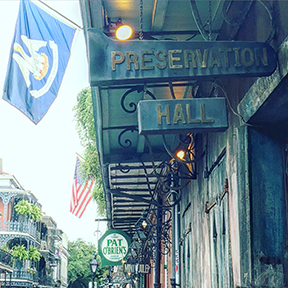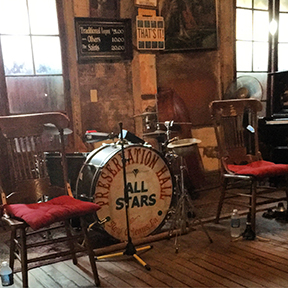It was a small, dimly lit room filled with old wooden benches, a few tattered cushions on the floor, and paint peeling off the walls. If you didn’t know better, you’d think it was on the verge of being condemned by the City of New Orleans.
 The line to get in extended far down St. Peters Street, but thanks to my friend Casey Clark, he secured he and his wife Jody, my wife Lisa and me, VIP tickets allowing us to be ushered in to a seat right up front while the rest of the crowd squeezed into every nook and cranny in the tiny, non-air conditioned space. Then the “Joint Chiefs of Jazz” sauntered in and took their places. After a brief introduction, the horns came up and New Orleans jazz came alive.
The line to get in extended far down St. Peters Street, but thanks to my friend Casey Clark, he secured he and his wife Jody, my wife Lisa and me, VIP tickets allowing us to be ushered in to a seat right up front while the rest of the crowd squeezed into every nook and cranny in the tiny, non-air conditioned space. Then the “Joint Chiefs of Jazz” sauntered in and took their places. After a brief introduction, the horns came up and New Orleans jazz came alive.
It was my first visit to Preservation Hall, but certainly not my last.
My wife Lisa recalled visiting years ago with her parents on trips to the Crescent City. For the countless times I’ve stayed in the greatest city in the world, I’d never experienced this remarkable piece of history.
Built more than two centuries ago, let that sink in, this tiny building has served a variety of purposes from a tavern to a tinsmith’s shop. But 55 years ago this week it became the now iconic Preservation Hall, intent on preserving authentic New Orleans jazz.
It wasn’t long ago I watched a documentary “Sonic Highways” on HBO produced by Dave Grohl and his rock band “Foo Fighters,” where they visited Preservation Hall in New Orleans to experience authentic jazz themselves. They even held an impromptu concert in the Hall with the Preservation Hall Jazz Band joining in.
I was struck by a moment on a related 60 Minutes story about the documentary when Grohl said the visit to New Orleans “changed his life.”
“It made me fall in love with music all over again,” he said.
 My experience at Preservation Hall was similar in that it made me fall even more in love with jazz.
My experience at Preservation Hall was similar in that it made me fall even more in love with jazz.
The show opened with the classic “Bourbon Street Parade.” I’ve always loved the Wynton Marsalis version I own, but something about hearing it up close and personal takes it to another level. It would only get better when Louis Ford took over on clarinet with “Clarinet Marmalade.”
Throughout the performance I kept looking at a small sign hung on the wall behind the band stating simply traditional requests are $5, any others are $10, and “The Saints” are $20.
It was worth a whole lot more than that when the trombone and coronet kicked off this most recognized New Orleans tune. A quick check of my iTunes and I realized I have eight different versions of “The Saints.” None could match the sound of the “Joint Chiefs” on this night.
Walking out of the seemingly crumbling building, looking back at the dingy brass letters on two beat-up music cases hanging over the door, the only real sign on the exterior of the building, I was overwhelmed with what we had taken in.
The authenticity of this ancient shack was as genuine as the music itself.